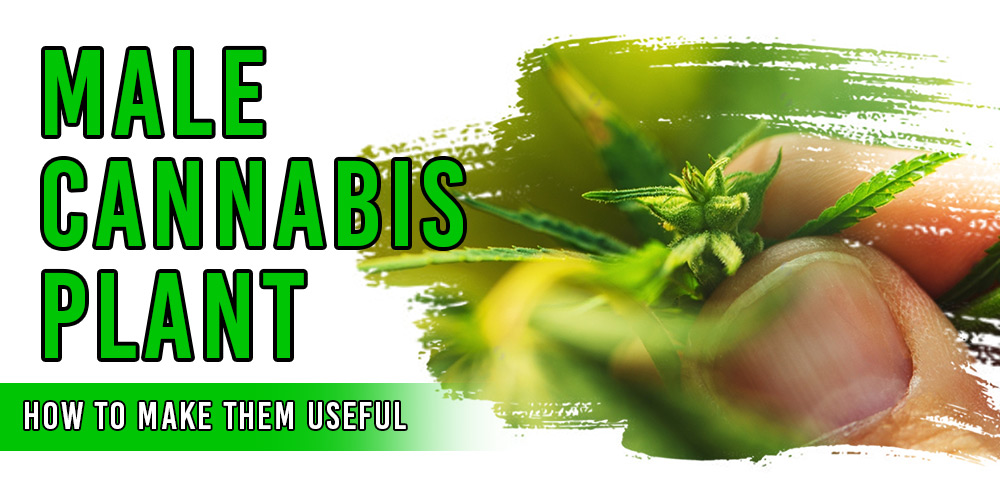



Table of Contents
ToggleTo fully comprehend the potential of male cannabis plants, it’s crucial to recognize them and understand their characteristics.
Male cannabis plants can be distinguished from female plants through their pre-flower features. Look for these telltale signs:
Distinctive Pollen Sacs: Male plants develop small sacs filled with pollen, resembling tiny clusters of grapes. This is a clear indicator of their gender.
Lack of Hairs: Unlike their female counterparts, male plants do not produce pistils or hairs. This distinction is vital for identification.
Male cannabis plants undergo several growth stages, each with its unique characteristics and significance.
Seedling Stage: The journey begins in the seedling stage, where the plant sprouts its first set of leaves. This phase sets the foundation for future growth.
Vegetative Stage: During the vegetative stage, the plant grows larger and develops more leaves, preparing for its reproductive phase.
Pre-Flowering Stage: This critical stage is when male plants start revealing their gender, showcasing pollen sacs. Recognizing this stage is pivotal for cultivation.
Flowering Stage: Male weed plant flowering stage can also be achieved, but there are no such things as male plant buds like their female counterparts. Understanding this distinction is vital.
Now that we can distinguish male cannabis plants and appreciate their growth stages, let’s explore how to harness their potential effectively.
Breeding is one of the most prominent and essential uses of male cannabis plants. Here’s a deeper look at their role in this process:
Genetic Variation: Male plants provide genetic material in the form of pollen. This pollen contains the male plant’s unique genetic makeup, which can be used to crossbreed with female plants. By doing so, breeders can create entirely new cannabis strains with specific traits, such as flavor, aroma, potency, and growth characteristics.
Stabilizing Traits: Breeders often aim to stabilize desirable traits within a strain. For example, if a particular strain has excellent resistance to pests or diseases but lacks in potency, a male plant with the desired resistance traits can be used to crossbreed with a high-potency female plant. This process allows breeders to combine the best of both worlds, creating a more robust and well-rounded strain.
Creating Unique Varieties: Male plants are instrumental in creating unique and novel cannabis varieties that cater to the preferences of different consumers. Whether it’s a strain designed for therapeutic purposes, recreational use, or specific growing conditions, male plants are essential in bringing these creations to life.
Controlled Pollination: Controlled pollination is a crucial aspect of breeding. Breeders can carefully select which male plants to use, ensuring that they have the desired characteristics. This precision allows for the deliberate creation of strains that meet specific market demands.
Hemp cultivation relies heavily on male cannabis plants for several reasons:
Seed Production: Hemp is cultivated primarily for its seeds, which are rich in protein, fiber, and essential fatty acids. Male plants contribute significantly to seed production by fertilizing female hemp plants. This process results in the development of hemp seeds, which have a wide range of applications, from food products to industrial use.
Fiber Quality: Hemp fibers from male plants are typically of higher quality than those from female plants. These fibers are prized for their strength and durability, making them ideal for textiles, paper, and various industrial applications. As such, male plants are crucial in producing top-grade hemp fibers.
While male cannabis plants do not produce the resin-rich buds that females do, they still contain valuable cannabinoids in their leaves and stems. This aspect of male plants opens up several possibilities for cannabis extraction:
Cannabinoid Extraction: The leaves and stems of male plants contain cannabinoids such as CBD (cannabidiol) and CBG (cannabigerol). These compounds have gained popularity for their potential therapeutic benefits. Extracting cannabinoids from male plants can be a cost-effective way to produce CBD-rich extracts without relying solely on female plants.
Medicinal Products: CBD and other cannabinoids extracted from male cannabis plants can be used to create various medicinal products, including oils, tinctures, capsules, and topicals. These products have been utilized for their potential to alleviate pain, reduce anxiety, and manage various medical conditions.
Research and Development: Male plant extracts can also be valuable for research purposes, allowing scientists to study the therapeutic properties of different cannabinoids and their potential applications in medicine.
Beyond their role in cultivation, male cannabis plants can serve as beneficial companion plants in gardens and agriculture:
Natural Pest Control: Male plants emit aromatic compounds that can help deter certain pests. Placing male cannabis plants strategically in a garden can contribute to a more pest-resistant environment for other crops.
Shade and Microclimate: The large, leafy canopy of male cannabis plants can provide shade for other plants in the garden. This shade can help regulate soil temperature and create a more stable microclimate, promoting healthier growth for neighboring crops.
In conclusion, male cannabis plants may not be the stars of the cannabis cultivation show, but they possess significant roles and potential. Whether for breeding programs, hemp production, cannabis extracts, or as garden companions, male plants offer unique contributions. Understanding their growth stages and the multifaceted ways they can be utilized allows cultivators to make the most of male cannabis plants.
Can male cannabis plants get you high?
No, male cannabis plants do not produce the psychoactive compound THC, typically associated with the euphoric “high.”
How can I prevent accidental pollination of my female cannabis plants by males?
Maintain physical separation between male and female plants, removing males once their pollination purpose is fulfilled.
Are male cannabis plants legal to grow in all regions?
Cannabis cultivation laws vary by location, so it is essential to research and adhere to local regulations.
What is the best stage to identify male cannabis plants?
Male cannabis plants can be confidently identified during the pre-flowering stage when they develop distinct pollen sacs.



Best Selling
Feminized Seeds
Regular Seeds
Customer Help
Contact Us
WE SELL MARIJUANA SEEDS IN THE USA

Are You 18 Or Over?
YesOr
No By clicking yes, you certify that you are over 18. By using this website, you agree to our legal disclaimer.